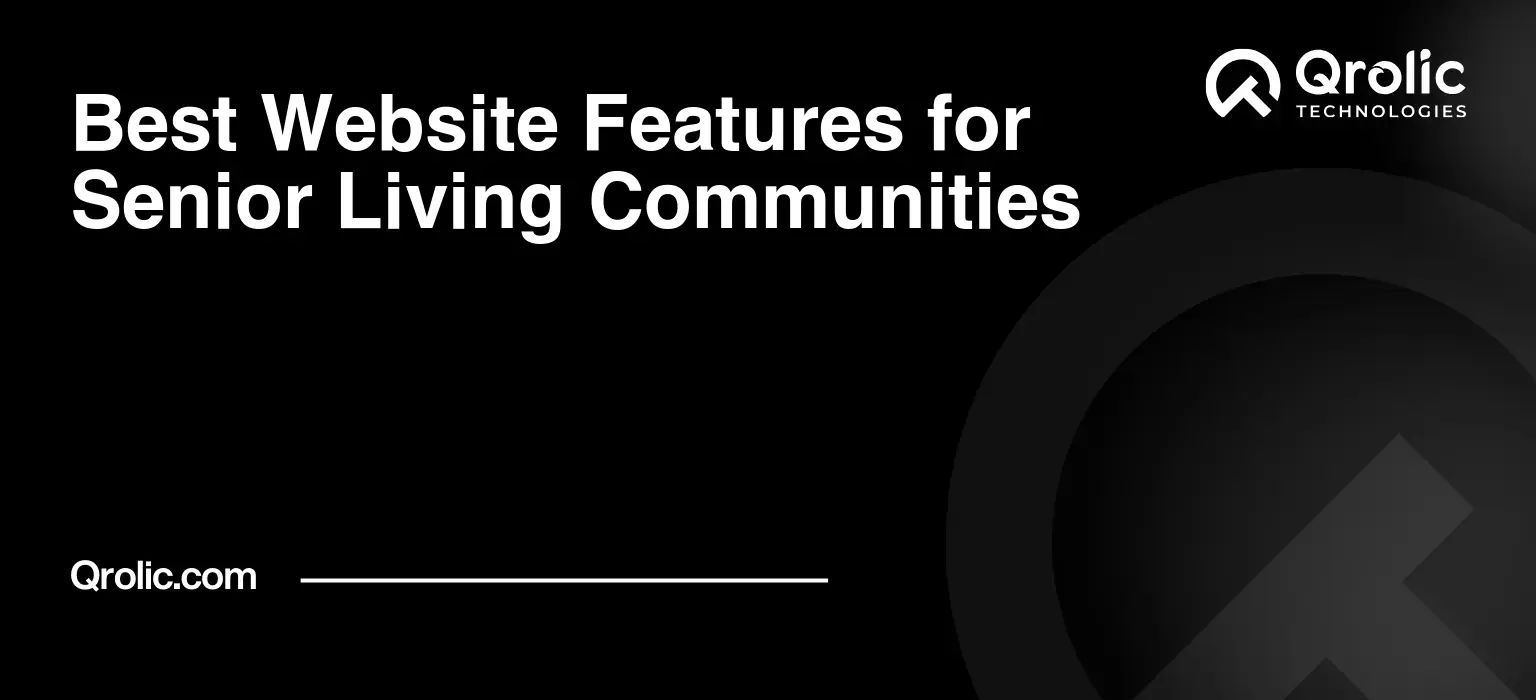Quick Summary:
- Make your website user-friendly and mobile-ready.
- Showcase your community with great visuals and testimonials.
- Optimize your site for search to attract families.
- A strong website is a vital investment.
Table of Contents
- The Digital Front Door: Why Your Senior Living Website Matters
- Why is a Strong Online Presence Crucial for Senior Living?
- Essential Website Features for Attracting Residents and Families
- 1. Intuitive Navigation and User-Friendly Design
- 2. Detailed Information About Services and Amenities
- 3. High-Quality Visual Content: Photos and Videos
- 4. Compelling Content that Addresses Family Concerns
- 5. Resident and Family Testimonials
- 6. Staff Profiles and Introductions
- 7. Calendar of Events and Activities
- 8. Online Contact Forms and Appointment Scheduling
- 9. Blog for Engagement and SEO
- 10. Accessibility Compliance
- 11. Security and Privacy
- Optimizing Your Senior Living Website for Search Engines (SEO)
- Keyword Research: Understanding What Families are Searching For
- On-Page Optimization: Making Your Website Search Engine Friendly
- Off-Page Optimization: Building Authority and Trust
- Technical SEO: Ensuring a Smooth User Experience
- Measuring and Analyzing Website Performance
- Avoiding Common Mistakes in Senior Living Website Design
- The Power of Qrolic Technologies in Building Your Ideal Website
- Why Choose Qrolic Technologies for Your Senior Living Website?
- Future Trends in Senior Living Website Design
- Conclusion: Your Website is an Investment in Your Future
The Digital Front Door: Why Your Senior Living Website Matters
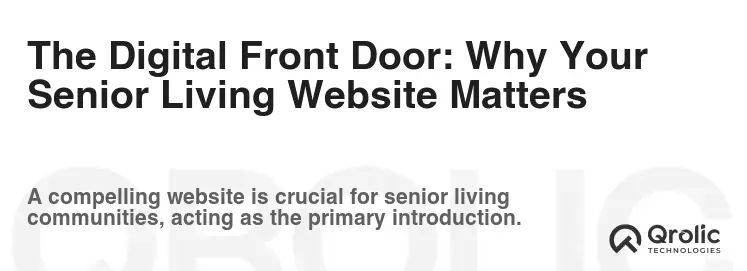
In today’s interconnected world, your website is often the first interaction potential residents and their families have with your senior living community. It’s more than just an online brochure; it’s a digital front door that can significantly impact occupancy rates and overall success. A well-designed senior living website builds trust, provides crucial information, and guides visitors through the decision-making process. Ignoring its potential is like locking your physical doors and hoping people wander in.
Why is a Strong Online Presence Crucial for Senior Living?
- First Impressions Matter: Your website is often the initial touchpoint. Make it count! A professional, user-friendly assisted living site projects credibility and competence.
- Information Hub: Families are seeking detailed information about care options, amenities, pricing, and community life. Your website is the central repository for all of this.
- Competitive Edge: In a saturated market, a compelling elder care website can differentiate your community and attract prospective residents.
- 24/7 Accessibility: Information is available around the clock, catering to different schedules and time zones.
- Lead Generation: Your website can capture leads through contact forms, appointment scheduling, and downloadable resources.
- Building Trust and Transparency: Showcasing testimonials, staff profiles, and virtual tours builds confidence and eliminates uncertainty.
- Accessibility for All: Ensuring your website is accessible to individuals with disabilities, including seniors, is not just ethical but also expands your reach.
Essential Website Features for Attracting Residents and Families
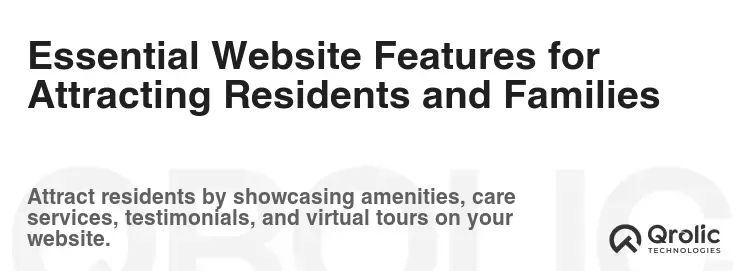
To create a senior living website that truly resonates with your target audience, focus on incorporating the following key features:
1. Intuitive Navigation and User-Friendly Design
- Clear and Simple Menu Structure: Avoid jargon and technical terms. Use straightforward language like “About Us,” “Our Services,” “Contact Us,” and “Photo Gallery.”
- Mobile Responsiveness: Ensure your website is easily accessible and functional on all devices – smartphones, tablets, and desktops. Google prioritizes mobile-friendly sites in search rankings.
- Large, Readable Fonts: Older adults may have vision impairments. Opt for larger font sizes and high contrast color schemes.
- Easy-to-Find Contact Information: Prominently display your phone number, email address, and physical address on every page.
- Search Functionality: Allow visitors to quickly find specific information using a search bar.
2. Detailed Information About Services and Amenities
- Comprehensive Service Descriptions: Clearly outline the types of care offered (independent living, assisted living, memory care, skilled nursing), including specific services like medication management, personal care assistance, and therapy.
- Pricing Transparency: While providing exact pricing can be complex, offer clear information about pricing structures, included services, and potential additional costs. Consider providing a cost calculator or a downloadable pricing guide.
- Amenity Highlights: Showcase the amenities that make your community special, such as dining options, fitness centers, libraries, recreational activities, and transportation services.
- Floor Plans and Community Maps: Provide detailed floor plans of apartments and common areas to give visitors a better understanding of the living spaces. A community map helps orient visitors and highlight key locations.
3. High-Quality Visual Content: Photos and Videos
- Professional Photography: Invest in high-quality photos that capture the warmth, comfort, and vibrancy of your community. Avoid stock photos that look generic. Show residents engaging in activities, enjoying meals, and interacting with staff.
- Virtual Tours: Offer virtual tours of apartments, common areas, and amenities to allow potential residents and their families to experience your community remotely. 360-degree views and interactive features can enhance the virtual tour experience.
- Resident and Staff Videos: Share videos that showcase resident testimonials, staff interviews, and community events. Authentic videos can build trust and create a personal connection.
- Image Optimization: Optimize all images for web use to ensure fast loading times. Use descriptive file names and alt tags for SEO purposes.
4. Compelling Content that Addresses Family Concerns
- Blog Posts and Articles: Create informative blog posts and articles that address common questions and concerns related to senior living, such as:
- “How to Choose the Right Senior Living Community”
- “Understanding the Different Levels of Senior Care”
- “Financing Options for Senior Living”
- “Signs That Your Loved One Needs Assisted Living”
- “Tips for Transitioning to Senior Living”
- FAQ Section: Address frequently asked questions about your community, services, and policies.
- Downloadable Resources: Offer downloadable guides, checklists, and brochures that provide valuable information and resources.
- Caregiver Resources: Include resources specifically for caregivers, such as tips for managing caregiver stress and links to support organizations.
5. Resident and Family Testimonials
- Authentic Testimonials: Share authentic testimonials from residents and their families about their experiences at your community. Positive testimonials can significantly influence decision-making.
- Video Testimonials: Video testimonials are even more powerful than written testimonials.
- Permission and Privacy: Always obtain permission before sharing testimonials and ensure compliance with privacy regulations.
6. Staff Profiles and Introductions
- Highlight Key Staff Members: Introduce key staff members, such as the executive director, nurses, and activities director, with photos and brief biographies.
- Showcase Expertise and Compassion: Emphasize the qualifications, experience, and compassion of your staff.
- Build Trust and Personal Connection: Helping potential residents and their families get to know your staff can build trust and create a more personal connection.
7. Calendar of Events and Activities
- Showcase Community Life: Highlight the vibrant activities and events happening at your community.
- Regular Updates: Keep the calendar of events updated regularly to reflect current activities.
- Photo and Video Coverage: Share photos and videos of past events to showcase the fun and engaging atmosphere of your community.
8. Online Contact Forms and Appointment Scheduling
- Easy-to-Use Contact Forms: Provide easy-to-use contact forms for inquiries, appointment scheduling, and information requests.
- Prompt Response: Respond to inquiries promptly and professionally.
- Online Appointment Scheduling: Allow potential residents and their families to schedule tours and consultations online.
9. Blog for Engagement and SEO
- Informative and Engaging Content: Regularly publish informative and engaging blog posts on topics related to senior living, aging, and caregiving.
- Keyword Optimization: Optimize blog posts for relevant keywords to improve search engine rankings.
- Shareable Content: Create content that is easily shareable on social media.
- Establish Authority: Blogging helps establish your community as a trusted source of information.
10. Accessibility Compliance
- WCAG Guidelines: Ensure your website complies with the Web Content Accessibility Guidelines (WCAG) to make it accessible to individuals with disabilities.
- Assistive Technology Compatibility: Test your website with assistive technologies, such as screen readers, to ensure compatibility.
- Inclusive Design: Use inclusive design principles to create a website that is welcoming and accessible to all users.
11. Security and Privacy
- HTTPS Encryption: Use HTTPS encryption to protect sensitive data transmitted through your website.
- Privacy Policy: Clearly outline your privacy policy and how you collect, use, and protect personal information.
- Data Security Measures: Implement robust data security measures to protect against cyber threats.
- Compliance with Regulations: Ensure compliance with relevant privacy regulations, such as HIPAA.
Optimizing Your Senior Living Website for Search Engines (SEO)
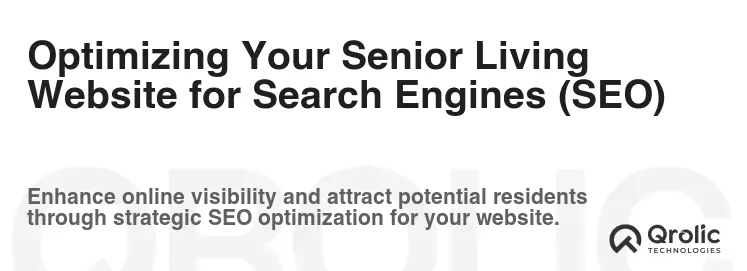
Having a beautiful and informative senior living website is only half the battle. You also need to ensure that potential residents and their families can find it through search engines like Google. Search Engine Optimization (SEO) is the process of optimizing your website to rank higher in search results.
Keyword Research: Understanding What Families are Searching For
- Identify Relevant Keywords: Use keyword research tools (e.g., Google Keyword Planner, SEMrush) to identify the keywords and phrases that families are using to search for senior living options in your area. Examples include: “senior living [city]”, “assisted living near me”, “memory care facilities”, “elder care services”, “retirement communities”.
- Long-Tail Keywords: Focus on long-tail keywords (longer, more specific phrases) to target a more niche audience and improve your chances of ranking. For example, instead of “assisted living,” try “assisted living facilities with memory care in [city]”.
- Competitor Analysis: Analyze your competitors’ websites to identify the keywords they are targeting.
On-Page Optimization: Making Your Website Search Engine Friendly
- Title Tags: Optimize title tags with relevant keywords. Each page should have a unique and descriptive title tag.
- Meta Descriptions: Write compelling meta descriptions that summarize the content of each page and encourage users to click.
- Header Tags (H1-H6): Use header tags to structure your content and highlight important keywords. Use only one H1 tag per page.
- Content Optimization: Incorporate relevant keywords naturally into your website content. Focus on providing valuable and informative content that answers users’ questions.
- Image Optimization: Optimize images with descriptive file names and alt tags.
- Internal Linking: Link to other relevant pages on your website to improve navigation and SEO.
- URL Structure: Use clear and concise URLs that include relevant keywords.
Off-Page Optimization: Building Authority and Trust
- Link Building: Earn high-quality backlinks from other reputable websites in your industry.
- Local Citations: List your community in online directories and local citation sites. Ensure your NAP (Name, Address, Phone number) information is consistent across all listings.
- Social Media Marketing: Promote your website content on social media platforms to increase visibility and drive traffic.
- Online Reviews: Encourage residents and their families to leave positive reviews on Google, Yelp, and other review sites.
Technical SEO: Ensuring a Smooth User Experience
- Website Speed: Optimize your website for speed to ensure fast loading times. Use tools like Google PageSpeed Insights to identify areas for improvement.
- Mobile-Friendliness: Ensure your website is mobile-friendly.
- Site Structure: Create a clear and logical site structure to make it easy for search engines to crawl and index your website.
- XML Sitemap: Submit an XML sitemap to Google Search Console to help Google discover and index your website.
- Robots.txt File: Use a robots.txt file to control which pages search engines can crawl.
- Broken Link Check: Regularly check for and fix broken links on your website.
Measuring and Analyzing Website Performance

It’s crucial to track your website’s performance to understand what’s working and what needs improvement. Use analytics tools like Google Analytics to monitor key metrics, such as:
- Website Traffic: Track the number of visitors to your website.
- Bounce Rate: Monitor the percentage of visitors who leave your website after viewing only one page.
- Time on Page: Track the average amount of time visitors spend on each page.
- Conversion Rate: Measure the percentage of visitors who complete a desired action, such as filling out a contact form or scheduling a tour.
- Keyword Rankings: Track your website’s rankings for relevant keywords.
Analyze your website’s performance data to identify areas for improvement and make data-driven decisions to optimize your website and improve results.
Avoiding Common Mistakes in Senior Living Website Design
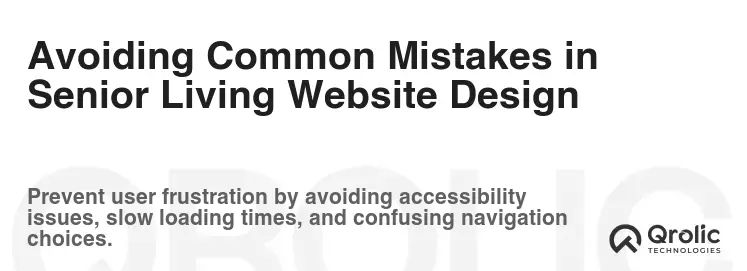
Several common mistakes can hinder the effectiveness of your assisted living site. Be sure to avoid these pitfalls:
- Cluttered Design: Too much information or visual clutter can overwhelm visitors.
- Outdated Information: Keeping information current is critical, especially regarding pricing, services, and contact details.
- Lack of Mobile Optimization: In today’s mobile-first world, a non-responsive website is a major turn-off.
- Poor Quality Images: Blurry, unprofessional, or generic stock photos can damage your credibility.
- Ignoring Accessibility: Failing to comply with accessibility guidelines alienates a significant portion of your target audience.
- Neglecting SEO: Without SEO, your website may not be found by potential residents and their families.
- Not Tracking Results: Without analytics, you can’t measure the effectiveness of your website and make data-driven improvements.
The Power of Qrolic Technologies in Building Your Ideal Website
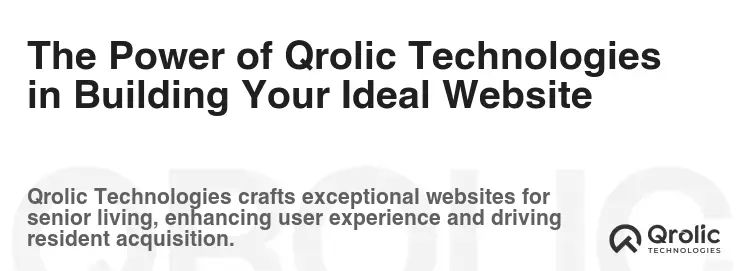
At Qrolic Technologies (https://qrolic.com/), we understand the unique challenges and opportunities of the senior living industry. We specialize in creating custom elder care websites that are not only visually appealing but also strategically designed to attract residents, engage families, and drive occupancy.
Why Choose Qrolic Technologies for Your Senior Living Website?
- Industry Expertise: We have extensive experience working with senior living communities and understand the specific needs and preferences of your target audience.
- Custom Website Design: We create custom websites that are tailored to your community’s unique brand and messaging.
- User-Friendly Design: We prioritize user-friendly design to ensure that your website is easy to navigate and accessible to all users.
- Mobile-First Approach: We design websites that are fully responsive and optimized for mobile devices.
- SEO Optimization: We implement comprehensive SEO strategies to help your website rank higher in search results.
- Content Creation: We can help you create compelling and informative content that engages your target audience.
- Ongoing Support: We provide ongoing support and maintenance to ensure that your website remains up-to-date and secure.
- Accessibility Compliance: We build websites that comply with accessibility guidelines to ensure that they are accessible to individuals with disabilities.
Let Qrolic Technologies help you create a senior living website that truly reflects the quality of your community and attracts the residents you deserve. Contact us today for a free consultation!
Future Trends in Senior Living Website Design

The digital landscape is constantly evolving, and it’s important to stay ahead of the curve. Here are some future trends in senior living website design to watch out for:
- Personalization: Websites will become more personalized, delivering tailored content and experiences based on user data.
- Artificial Intelligence (AI): AI-powered chatbots and virtual assistants will provide instant support and answer questions.
- Voice Search Optimization: Websites will be optimized for voice search to cater to the growing use of voice assistants.
- Augmented Reality (AR): AR experiences will allow potential residents and their families to virtually explore your community.
- Data-Driven Design: Website design will be increasingly driven by data and analytics.
- Focus on Wellness: Websites will emphasize the wellness and lifestyle aspects of senior living.
By embracing these future trends, you can ensure that your senior living website remains competitive and effective in the years to come.
Conclusion: Your Website is an Investment in Your Future
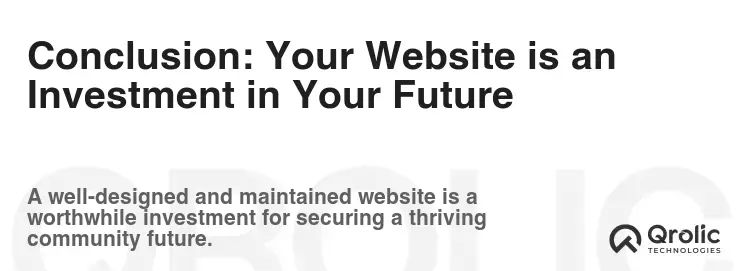
Investing in a well-designed, informative, and SEO-optimized senior living website is an investment in the future of your community. By providing a positive online experience, you can attract more residents, build trust with families, and establish your community as a leader in the senior living industry. Don’t underestimate the power of your digital front door. Make it welcoming, informative, and engaging, and watch your occupancy rates soar. The time to invest in your assisted living site and elder care website is now.
